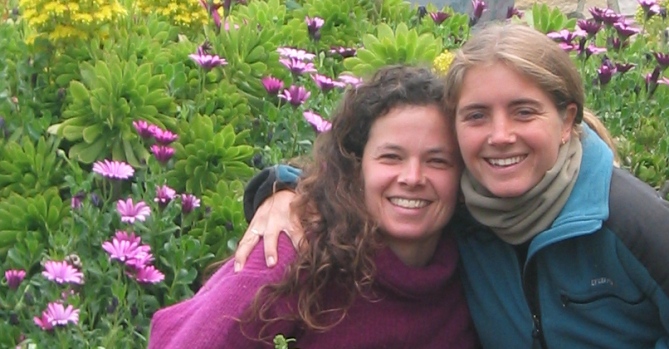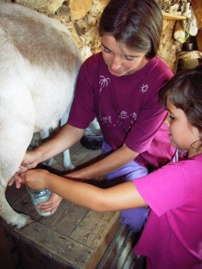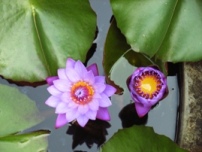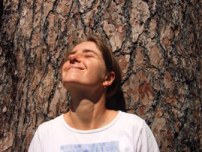
Meditation courses in our times can be divided into two schools: one with the opinion that the course is meant for doing and the second one that it is meant for non-doing. The first one stresses perseverance and effort; the second emphasizes letting go and rest. The first one is exemplified by those awe-inspiring three month retreats in Sri-Lanka, or, at least, by the Goenkaji 10-day courses; in the second pole you will find Thich Naht Hahn's teaching method, or, with many differences, the advaitic [nondual] satsang teachings.
Any attempt to fit the courses offered by the teachers of Open Dharma will not be successful. Jaya, Gemma and Ajay, the teachers of this small group, succeed in maintaining a frame of practice that has a very flexible agenda, but that invites and encourages deep and serious inner work. Once on the course, everyone is asked to start from the place where he or she is, and to find his or her own way. These three teachers will meet him or her right there, and right from there will they continue. The challenge they are facing, then, is first to identify the particular state and needs of the practitioner and after that to awaken within him or her the tools and the strength to go on from there. During the two courses I took part in, about half a year ago in south India, the teachers succeeded in doing so in an impressive way.
Open Dharma is only six or seven years old, but this group of teachers has already managed to attract a large number of admirers. Ajay, of Indian origin and about fifty, Jaya, an American going on forty, and Gemma, originally from Spain and this year celebrating her 30th birthday, give a rare combination of compassion and deep spiritual wisdom. There is something in the way they teach that allows for self-discovery in every sense of the word: discovery of yourself, by yourself.
Jaya grew up in the south-east of the US, and arrived in India
in 1987, as part of a program for religious studies during her
years at Harvard. Then, in Bodh Gaya, she had her first encounter
with meditation and felt at home. In 1990, she traveled to Lucknow
in north India, and spent years with Sri Poonjaji (Papaji), until
his death in 1997. “The most important thing he emphasized
to me,” says Jaya, “is not to lean on his “name
and form” too much. He showed me that the heart of the matter
was not him, and not me, but something bigger than both of us.”
During the nineties in Lucknow she met Ajay and his family, and
a strong friendship was formed between them.
Formerly a real estate trader, Ajay is a government clerk who
lives in Lucknow with his family. He started his spiritual investigation
totally on his own. As well as having degrees in Law, Social-Work,
and Sanskrit, he studied yoga. He and Jaya became good friends
in 1991 and years later also began teaching together. When they
were already a “known institution,” Gemma joined them
and Open Dharma as we now know it was born.
Gemma, full of crackling energy like a japanimation figure, is one of the wisest women I have ever met. Often when I sat before her I felt that she knew something about me that I myself did not. She was born in Barcelona in 1976 and started meditating at the age of 11, on her own account. As a teenager she learnt about spirituality from a mysterious woman who took Gemma under her wing. Gemma also practiced Zen for 10 years and spent 2 years as a nun, one in a contemplative community and one in the Dominican Republic.
As I said, their courses have a unique character. In spite of being quite experienced in formal meditation, they do not lay stress on such practice when they teach. Jaya says the principle that guides them is openness: “We try to let the practitioners find their own rhythm. For instance, we give a lot of free time, time to rest. We want to see what comes up out of that.”
Meditation itself is done a lot of the time lying down. Jaya says that from her experience, meditating lying down betters the whole process. “People have a lot of resistance to lying down while meditating. Especially if they come on a course, they want to 'get something out of it,' and they think therefore they have to work hard, to sit and to concentrate. But the sitting position is a work posture nowadays, not a relaxing posture. Breaking through the attachment to this concept of meditation makes the whole lying down issue that much more interesting and meaningful.” Gemma concurs: “Lots of people, if they sit in meditation, immediately get the feeling that they are 'going to work', and a negative sort of effort starts, with pressure. In our courses we allow people to choose: you can have a 'vipassana retreat' and you can 'do nothing.' What we hope is that people won't obey a certain framework just because it is preconceived in their mind. On the other hand, we hope people will not choose to escape and do nothing all day. We offer the space and the support in which everyone can find his or her way. And it's not any easier than a normal vipassana retreat, because here the responsibility is on each and every one.”
“But can't a problem arise,” I asked, “considering that when given the opportunity to sleep, we usually take it?” Jaya doesn't think so: “Many times people 'try' much too much. There is perfectionism, pressure and a negative kind of seriousness.” Gemma adds that one of the most difficult things for people is to let go: “People get themselves stressed out all the time. It's surprising, but people tend to like harsh and tough practice. It's much harder for them to just lie on the down and trust that all will be well. We invite them to bring the heart, and see what happens. It's hard work, which demands a passion and a great love for life. It means saying a big 'yes' to life, and running away from nothing. It's not easy. The problem is that each one of us had an idea of how meditation should look, and we try to fight anything that strays from that view. We suggest: no idea. Everything that comes is welcome. And from this point find your inner wisdom, find your own way.”
So is a person coming to the course asked to just listen to whatever comes up? Gemma stresses that it's a very personal matter: “We don't ask everybody for the same thing. Each person is in a different moment, in a different place. Different people we can guide in different ways.”
Gemma, as I said, practiced Zen meditation for ten years. Today she says that Zen was the basis for her, meaning her experience with Zen took her to a certain point, but could not take her further. “There is nothing that we can copy from outside, take from outside, that will take us all the way, because we really are asked to be in intimate relationship with the process we are going through. There are techniques that can help a lot. I am not against ways and methods. They can take us to a certain point from which we can see more clearly what we need, hear our inner voice more clearly. But from that point we need to let that seeing, that voice, guide us.”
A certain word that keeps recurring in the group’s talks is “heart.” There is a lot of talk about discovering the heart, checking with the heart, listening to the heart – I asked them to clarify what they meant by it. “What we mean by it is for you to be yourself,” says Gemma. “Find your own voice, the voice that is meaningful for you and right for you. It is very easy to walk after or simply follow others, and to get used to it, and to get stuck. If we had enough faith, everything would be revealed to us. From inside. But we don't have enough patience to listen to that voice, and we want quick results, so we are tempted to take ways that are not good for us. I'm not saying that a certain teacher, or a friend, cannot help us. But it is very important to listen to ourselves all the time. Even after we have a way that we practice, we have to listen to ourselves. The quest has to be alive, and a living thing has to change from time to time. I see people who have great tools, tools that have grown very sharp through years of practice, but they are going in circles, because those tools are no longer useful for them. The challenge they are facing now is to let go of those tools, even if they were very good and brought them to where they are.”
Another question I wondered about is whether people for whom this is the first encounter with meditation could find that inner voice in a course that is built in such a flexible way – is there not some preliminary work in order to get some stability in the mind? Gemma says that is the challenge they take upon themselves. “The amazing thing,” she says, “is that we get good results. People who had no experience in meditation or spiritual work understand very subtle things. And if things can come out of the inner wisdom of people instead of us telling them, so much the better.” Jaya: “Basically there are people that require a structure to push them forward, and there are people for whom a lack of structure is what pushes them forward. In our courses we offer different degrees of structure, but we always want to let people have the opportunity to find out for themselves. From our experience 'new' people can find out very deep things, things that in a strict structure would only come up later. Of course, it is also important to see what happens in the long-run, because not only what happens in the course is important, but how things evolve after it. The point is not to make a positive experience in the course, but to give real tools for growth after it.”
Ajay is an interesting case of a man who went on the spiritual path totally by himself. He says that “everything just happened. It was one long process that went on inside me. I tried to find answers to questions that were bugging me, and I didn't think anybody around could help. I went after the inner voice that guided me. Really I didn't have a choice – everything just happened. When I traded in real estate the only connection I had with any spiritual thing was lighting incense every morning in front of the statue of Durga [the female aspect of the Hindu divinity – T.P.], but the truth is that during the ceremony I would think all the time what to buy and what to sell, how to close this deal or that. One morning in 1986 while doing this, I suddenly thought to myself, how could it be that the lips are praying but the head is calculating money at the same time? This question began my search, the search also for that voice that was as if watching all this in me. As I said, from that moment I listened to my heart in order to know what to do, and devoted myself to it. After four and a half years I knew I understood. Over the next six or seven years I was trying to explain what I saw to people around me – not a simple thing at all as I soon found out.”
I asked Ajay what, being an Indian teaching westerners, he had to say about the western spiritual seeker. “I can say he or she has authenticity. Westerners have a real passion to find what they are looking for. If I were teaching Indians I would teach differently, because with Indians there are a lot of things you have to break down: a lot of beliefs and traditions. With westerners the belief system is already broken,” he smiled. “With them you can start from the beginning.”
“We start from the beginning,” says Jaya, “where
priorities are clear and there is great willingness to go deeply.
It's not a first stage of some system, but a way of living. Open
Dharma is an atmosphere more than a system, and that atmosphere
is love.”
Tomer Persico (2004)



